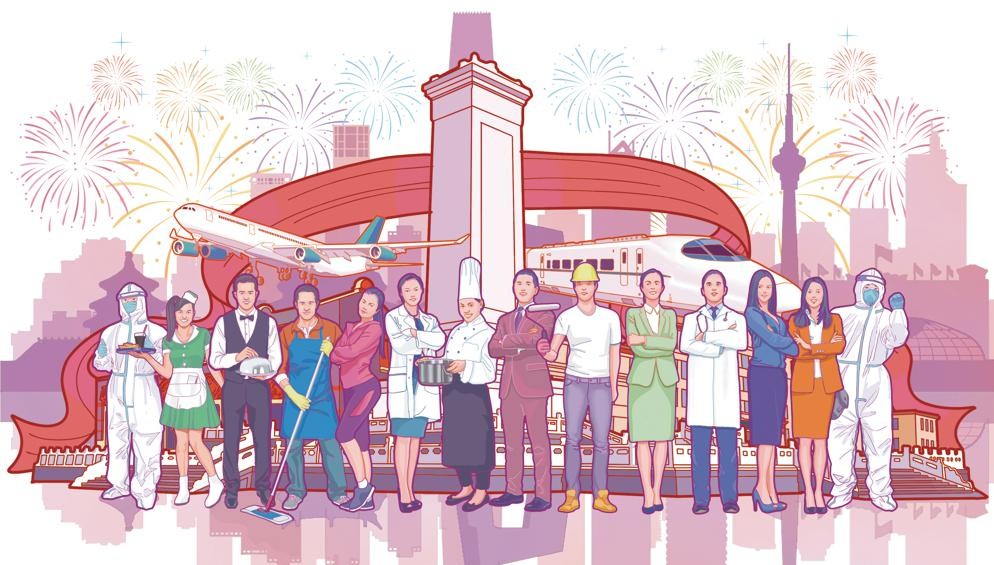
By Asit K. Biswas/Cecilia Tortajada
JIN DING/CHINA DAILY]
The speed, scale and span of the economic and social transformation of China during the past 40-odd years have been unprecedented in human history.
One hundred years ago, times were not good for China. Its 400 million people lived mainly in rural areas, mired in poverty. It was a nation ravaged by imperial mismanagement, foreign colonialism and civil wars.
On July 23 1921, 13 disillusioned Chinese young men and two representatives from the Communist International, met secretly in an inconspicuous house, 106 Rue Wantz, in Shanghai’s French Concession, which began the first national congress of the Communist Party of China (CPC). The police interrupted the meeting on July 30, and the Chinese members shifted their discussions to a tourist boat on the South Lake in Jiaxing, Zhejiang province, to continue the first National Congress. The first congress marked the founding of the CPC.
Mao Zedong became the leader of this fledgling party during the early days of struggle. The Party operated from primitive quarters dug in the hills of inland city of Yan’an. The cave-like quarters of these early leaders are now a far cry from the latest modern houses of Beijing or Shanghai.
It is perhaps unlikely that the pioneers imagined that in only 30 years, the party they formed would govern the nation and continue to lead the country on its successful journey even more than seven decades after that. Nor would they have imagined that the CPC would become the world’s largest ruling Party with some 95.15 million members in about a century.
Reform and opening-up lead to rapid development
In 1949, under the leadership of the CPC with Mao at its core, the People’s Republic of China was born.
The next pivotal transformation of China occurred in 1978, under the leadership of Deng Xiaoping, with the launch of the policy of reform and opening-up.
Prior to 1978, food shortages were a constant problem in China. Thus, initial institutional reforms started in the agricultural sector with two fundamental policy changes. First, prices of agricultural products were increased. Second, the collective farming system was gradually abolished and replaced with “household responsibility system”. Under this new system, each household had a fixed quota of grains that it had to sell to government at official prices. However, any extra produce could be sold at the market price, which was much higher.
These reforms were progressively implemented and were completed by 1984. Consequently, China’s agricultural output increased by 47 percent during 1978-1984.This solved the recurring food scarcity problems and initiated a structural transformation, leading to allocated surplus agricultural labor to industry. Within six years, over 49 million workers, 19 percent of China’s labour force, shifted from agriculture to industry.
Further reforms were implemented in the agricultural sector from 1990. Government interventions were reduced significantly. Except for some restrictions on land ownership, China now has one of the least distorted agricultural economies in the world.
This remarkable success in agriculture led to two major market reforms in the industrial sector during the early 1980s. First, State-owned enterprises were given production inputs and outputs quotas at official prices. However, beyond these quotas, they were free to buy inputs and sell outputs at market prices. Non-State-owned enterprises, including foreign-owned companies in special economic zones, were allowed to enter some sectors that were previously banned and could buy inputs and sell outputs at market prices.
Second, from 1980, many economic decision-making powers were devolved to lower levels of government, with added fiscal incentives. Consequently, State-owned enterprises at provincial, city and country levels, and collectives at township and village levels, proliferated.
All these reforms ensured China became the manufacturer of the world, boosting national GDP and people’s income.
In 1978, before the launch of the reform and opening-up process, China’s per capita GDP was one-fortieth that of the United States and one-tenth of Brazil. By 2020, its per capita GDP, at $10,500.40, was about one-sixth of the US, but 54 percent higher than Brazil. In terms of GDP, Japan Centre for Economic Research now forecasts China will surpass that of the US by 2028.
One impressive part of China’s policymaking is it does not have any preconceived ideas or dogmas. New policies are tried in pilot areas. If a policy works, it is further fine-tuned before it is rolled out nationwide. Accordingly, its record of successfully implementing nationwide policies is higher than most other countries.
An important success of its social and economic policies has been that it has now completely eradicated absolute poverty. In fact, a primary reason why the poverty alleviation target of the Millennium Development Goals of United Nations was achieved, was due to China’s success in lifting about 800 million people out of poverty in the past four decades, a remarkable 70 percent of entire global poverty eradication during this period.
Glorious future lies ahead China had announced two national
 Africa -China Review Africa -China Cooperation and Transformation
Africa -China Review Africa -China Cooperation and Transformation
